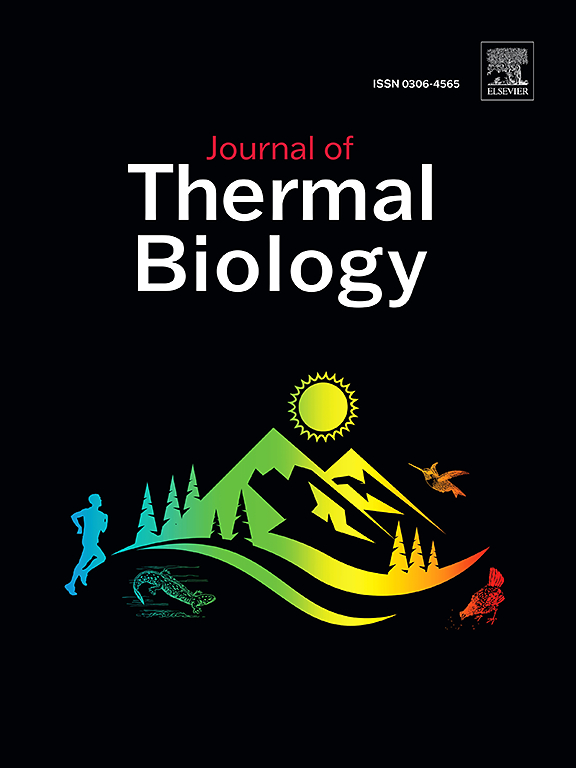Relationship between temperature and relative humidity with CO2 and CH4 concentration and ectoparasite abundance in blue tit (Cyanistes caeruleus) nests
IF 2.9
2区 生物学
Q2 BIOLOGY
引用次数: 0
Abstract
The presence of nestlings influences the microclimate inside avian nesting cavities. We explored the relationship between temperature and relative humidity and the abundance of ectoparasites and gas concentrations in blue tit nest boxes during the nestling period by comparing two years with differing climatic conditions. In the second year, we also manipulated the temperature and humidity inside the nest boxes. The average temperature in nest boxes was colder during 2016 than 2017; in the latter, even warmer conditions were attained due to the experimental manipulation of temperature. Carbon dioxide (CO2) concentration in the forest air was slightly lower in 2016 than 2017. However, in both years, the CO2 concentration of nest box air was higher than that of forest air, with 2017 showing a greater difference. Differences in brood size, larger in 2016, did not explain the difference in CO2 concentration. However, CO2 concentration was higher in nestboxes in the warmer year implying that at higher temperatures, organic matter decomposition likely accelerates, releasing more CO2 into the atmosphere. By contrast, CH4 concentration in nest-box air, which was similar in both years, was lower than that in forest air, particularly in the wettest and coldest year. Different relationships were found between the abundance of different ectoparasites and the temperature, relative humidity, and gas concentration measured at different days of nestling age. For example, a positive association is observed between flea larval abundance and temperature at nestling day 8, but a negative one is observed for mites under the same microclimate conditions. Moreover, a negative relationship was observed between the abundance of mites, midges, and blackflies and CH4 concentration at different nestling ages. These results suggest that changes in climatic conditions can also affect the concentrations of CH4 and CO2 inside and outside nest boxes, which in turn differentially affect ectoparasite abundance.
温度和相对湿度与蓝山雀巢内CO2和CH4浓度及外寄生虫丰度的关系
雏鸟的存在影响了鸟类巢腔内的小气候。通过2年不同气候条件的对比,探讨了雏鸟巢箱内温度、相对湿度与巢外寄生虫丰度和气体浓度的关系。第二年,我们还对巢箱内的温度和湿度进行了控制。2016年巢箱平均温度低于2017年;在后者中,由于对温度的实验操纵,甚至获得了更温暖的条件。2016年森林空气中的二氧化碳浓度略低于2017年。但两年中巢箱空气CO2浓度均高于森林空气,且2017年差异更大。2016年产卵量的差异更大,但这并不能解释二氧化碳浓度的差异。然而,在温暖的年份,巢箱中的二氧化碳浓度更高,这意味着在更高的温度下,有机物分解可能会加速,向大气中释放更多的二氧化碳。相比之下,巢箱空气中CH4浓度低于森林空气,两者相似,特别是在最湿和最冷的年份。不同日龄测定的温度、相对湿度和气体浓度与不同体表寄生虫的丰度有不同的关系。例如,在相同的小气候条件下,跳蚤幼虫丰度与雏鸟第8天的温度呈正相关,而螨虫则呈负相关。不同雏鸟龄期螨、蠓、蚋的丰度与CH4浓度呈负相关。这些结果表明,气候条件的变化也会影响巢箱内外的CH4和CO2浓度,从而对体外寄生虫的丰度产生不同的影响。
本文章由计算机程序翻译,如有差异,请以英文原文为准。
求助全文
约1分钟内获得全文
求助全文
来源期刊

Journal of thermal biology
生物-动物学
CiteScore
5.30
自引率
7.40%
发文量
196
审稿时长
14.5 weeks
期刊介绍:
The Journal of Thermal Biology publishes articles that advance our knowledge on the ways and mechanisms through which temperature affects man and animals. This includes studies of their responses to these effects and on the ecological consequences. Directly relevant to this theme are:
• The mechanisms of thermal limitation, heat and cold injury, and the resistance of organisms to extremes of temperature
• The mechanisms involved in acclimation, acclimatization and evolutionary adaptation to temperature
• Mechanisms underlying the patterns of hibernation, torpor, dormancy, aestivation and diapause
• Effects of temperature on reproduction and development, growth, ageing and life-span
• Studies on modelling heat transfer between organisms and their environment
• The contributions of temperature to effects of climate change on animal species and man
• Studies of conservation biology and physiology related to temperature
• Behavioural and physiological regulation of body temperature including its pathophysiology and fever
• Medical applications of hypo- and hyperthermia
Article types:
• Original articles
• Review articles
 求助内容:
求助内容: 应助结果提醒方式:
应助结果提醒方式:


